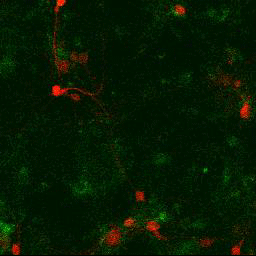Our Research
One of the primary challenges in neuroscience is to link complex neural phenomena to the structure and function of their composite neural circuits. Addressing this problem requires a thorough understanding of patterns of neural activity, and the ability to relate this to physiological processes, behavior and disease states. An essential step towards this goal is the simultaneous recording of neural activity in large, defined populations, ideally in intact circuitry. Traditional electrophysiological approaches provide excellent sensitivity and temporal resolution, but are limited in the number of cells that can be recorded simultaneously. We are combining computational protein design, chemical biology, electrophysiology, optical imaging techniques, and inducible pluripotent stem cell (iPSC) technology to describe the logic of the neural circuitry and how this logic relates to behavior and disease states.
I. Genetically encoded indicators of neural activity.
Fluorescent protein based biosensors can transfer changes in neural state (e.g. membrane potential or essential ion flux or enzyme activity) to fluorescence observables. They are genetically encoded, and can thus be used to label large populations of defined cell types and/or sub-cellular compartments. Combined with modern fluorescence imaging techniques, these probes allow us observe and track how neural networks are established or modified in time and space and find out what goes wrong in diseases. Our lab used a variety of techniques (computational protein engineering, rational design, molecular evolution, chemical synthesis) to develop genetically encoded imaging probes, such as calcium indicators, neurotransmitter sensors and kinase sensors. We also explore strategies for better targeting these sensors to small compartments in the nervous system, such as axon terminals, and for longer expression with reduced cytotoxicity in vivo.

Structure of genetically encoded calcium indicator
II. Neuron-glial interaction in health and disease.
We also integrate our imaging probes to induced pluripotent stem cells (iPSCs)-derived neurons and glias to create a platform for studying psychiatric diseases in vitro. Such cultured human neuronal networks will enable us to visulize how the precise, guided communication in neurons develops, and how it breaks down in diseases. With this system we can test a library of drugs to identify ones that can correct the communications defects in a patient-specific manner; such a drug screening would not be possible on living patients.

Dual-color imaging of neuron-astrocyte activity
